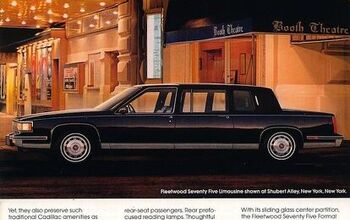Piston Slap: The Cadillac Hack

Geek alert! This one is tech-heavy!
TTAC Commentator Skor writes:
Sajeev,
Not a question, but it’s good to know that as long as there are cars there are people who will come up with hacks, no matter how complicated things get.
I have an 1992 Cadillac Seville and the blower motor fan disintegrated and jammed up the blower motor, which in turn shorted out the blower resistor. The squirrel cage disintegrated. I checked inside the blower housing to see if there was anything loose, but I could find nothing except pieces of the fan. All of this stuff was OE, no one has been in there since the car came from the factory. I’m sure someone at GM thought that saving a nickel on plastic was a good idea. Well, I bought a new motor/fan assembly and installed it. Wasn’t too bad, about $40. When I tried it, it was a no-go. Next thing I do is check the fuse (30 amp) it was fine. Then I checked the blower motor controller. It was blown. Crap! Apparently when the fan blew up, it jammed the motor, which then took out the motor controller. I’m thinking to myself:
“Nice engineering. The components on this circuit blow before the fuse does. WTF is the fuse for?”
So I call the Caddy stealer and he tells me $225 for the control module. Crap! I Check Autozone and they want $180. Crap! So I get my Google-Fu on and I end up at a Caddy enthusiast forum. A dude on the Caddy forum is an electrical engineer and he was so pissed when the same thing happened to his Caddy that he came up with this circuit that you can build from cheap discrete components.
I got my google-fu on and found a dude who hacked a new circuit together for about $10. I bought the parts but haven’t soldered the thing together yet. The link appears to be dead, and I can’t find the original thread anywhere. Fortunately, I took pictures of this hack, and still have them on my hard drive. You are welcome to use them. Please note: I DID NOT DESIGN THIS CIRCUIT. I took a course in basic electronics when I was in high school. If you give me a schematic, and parts list, I can build it, but I can’t design it. This circuit was designed by an electrical engineer, and I don’t know his name.
The connector block on the controller has 6 pins, but only 4 are used. There are only 4 wires on the harness plug.
Battery———————–NC————————Motor+
NC————————–Ground———————Input(control signal)
The battery and No-Connect on the left are spaced far from the other connections you have no problem telling left from right.
- The FET source is connected to the battery through a 30 amp fuse….it’s always hot, even with the key off.
The FET drain goes straight to the blower motor.
The TIP3055 base is connected to the control signal coming from the climate control computer. I don’t know what this signal looks like since I don’t have a scope. I put the VOM on it and when the climate control is switched on it can vary from .5V to 8+V.
TIP3055 emitter goes straight to chassis ground.
The cases of the semiconductors I used are TO-247. Normally I would mount stuff like this on mica (the transistor and FET’s net to be electrically insulated from the sink) with heat sink grease, but radio shack only sells mica for TO-220….too small. I ordered sil-pad from Digi-Key. The sil-pad cost $.24 a piece…..if you use sil-pad, you don’t need heat sink grease. The resistors are ½ watt, 5%, carbon film. After I soldered it together, I coated the bare solder connections with JB weld.
This is what the motor controller looked like when I pulled it out of the car.
I cut the original circuit board off the heat sink; one of those “thick film” things which is great for mass production but can’t be repaired…it would be like tying to unbake a cake. I bolted the discrete bits to the original sink and soldered it all together. Does it work? You betcha ya. I ran it for a half hour outside the blower housing. The transistor stays cool, the 3 FETs get a bit warm but nothing that could be described as hot. This is what the DIY version looks like.
When there is the will, there is a way.
Sajeev answers:
As the owner of several unloved Detroit techno-wonders from the 1980s, I have one thing to say about your last remark: So true.
Wait a second! I remember your amazing advice to me about my Fleetwood 75 Limo: you also know your TPS reports!
Look, most components are not that unique, anyone with basic knowledge of circuit boards and possession of factory wiring diagrams can fix just about any electronic bit on a car from the 1970s-1990s. I remember reading a C/D road test of a loaded out Fox body Ford LTD where the author remarked how difficult it will be to keep the electronics working decades from now. Whatever! I’ve learned how to fix many a Fox Ford electronic dashboard component, and I don’t even own a soldering gun!
The newer stuff is admittedly much harder, but that will change over time. I suspect someone within the B&B is already quite savvy with i-Drive interface rebuilding, or similar.
Once again: when there is a will, there is way. Hats off to you, my good man! The 1992 Seville was/is a wonderful design, and far easier to keep alive without that head bolt munching Northstar motor. You got one of my favorite GM products of the era, and that’s a compliment. So let’s show off your handiwork once more.
Send your queries to sajeev@thetruthaboutcars.com. Spare no details and ask for a speedy resolution if you’re in a hurry.

More by Sajeev Mehta
Latest Car Reviews
Read moreLatest Product Reviews
Read moreRecent Comments
- JMII I doubt Hyundai would spend the development costs without having some idea of a target buyer.As an occasional track rat myself I can't imagine such a buyer exists. Nearly $70k nets you a really good track toy especially on the used market. This seems like a bunch of gimmicks applied to a decent hot hatch EV that isn't going to impression anyone given its badge. Normally I'd cheer such a thing but it seems silly. Its almost like they made this just for fun. That is awesome and I appreciate it but given the small niche I gotta think the development time, money and effort should have been focused elsewhere. Something more mainstream? Or is this Hyundai's attempt at some kind of halo sports car?Also seems Hyundai never reviles sales targets so its hard to judge successful products in their line up. I wonder how brutal depreciation will be on these things. In two years at $40k this would a total hoot.So no active dampers on this model?
- Analoggrotto Colorado baby!
- Rob Woytuck Weight is also a factor for ferries which for instance in British Columbia, Canada are part of the highway system.
- Ajla I guess some people were big fans of Milli Vanilli and Real Dolls (don't Google that at work) but I have a very large problem with the fake engine sounds and fake transmissions. If you turn them off does it stay off forever or does it turn back on whenever you go into sport mode?
- Probert That X frame was a killer. No nostalgia for these things to be honest. Yup - life of the party....



































Comments
Join the conversation
Fuses tend to be slower to react to over current conditions compared to a semiconductor device. Also the durability of semiconductors to carry over current has greatly improved over the years. For example, early transistor audio amplifiers would blow out their output transistors if the speaker wires even touched for a brief instant. Today's amplifiers are very robust to faults in the output wiring.
A company I used to work for used small (2-5 hp) DC motor drives in their machines. The smaller ones, having no overload circuits, would frequently get overloaded, resulting in blown power output devices. The fuses would always be sitting there looking perfect, while the solid state devices looked like an overcooked dinner. Yes, the fuses are too slow to do any good. They protect the wiring.